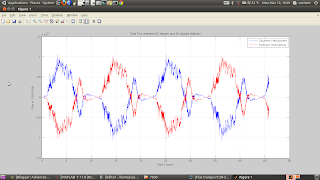The last term in the Master Equation,
is the advection term in the toroidal (phi) direction. This term is dealt with the Lax-Wendroff Scheme in the complex (and more accurate) code.
Simple first order accurate Euler scheme goes haywire after a few iterations, and does not conserve the peak of magnetic field (due to numerical diffusion).
But, the Lax-Wendroff scheme, which is second order accurate improves over the Euler Scheme, and preserves the peak of magnetic field, with negligible numerical diffusion.
A problem however, generally found with Lax-Wendroff schemes is, that some ripples can be seen behind the travelling wave. The total flux, and the magnetic field are still accurately conserved. But, due to the ripples, the unsigned flux suffers change with time; which is unphysical.
The simulation of a meridian-like flux tube shows the formation of these ripples.
For a movie of the simulation, play the video named Flux tube1.mp4 after clicking here .
is the advection term in the toroidal (phi) direction. This term is dealt with the Lax-Wendroff Scheme in the complex (and more accurate) code.
Simple first order accurate Euler scheme goes haywire after a few iterations, and does not conserve the peak of magnetic field (due to numerical diffusion).
But, the Lax-Wendroff scheme, which is second order accurate improves over the Euler Scheme, and preserves the peak of magnetic field, with negligible numerical diffusion.
A problem however, generally found with Lax-Wendroff schemes is, that some ripples can be seen behind the travelling wave. The total flux, and the magnetic field are still accurately conserved. But, due to the ripples, the unsigned flux suffers change with time; which is unphysical.
The simulation of a meridian-like flux tube shows the formation of these ripples.
For a movie of the simulation, play the video named Flux tube1.mp4 after clicking here .






































